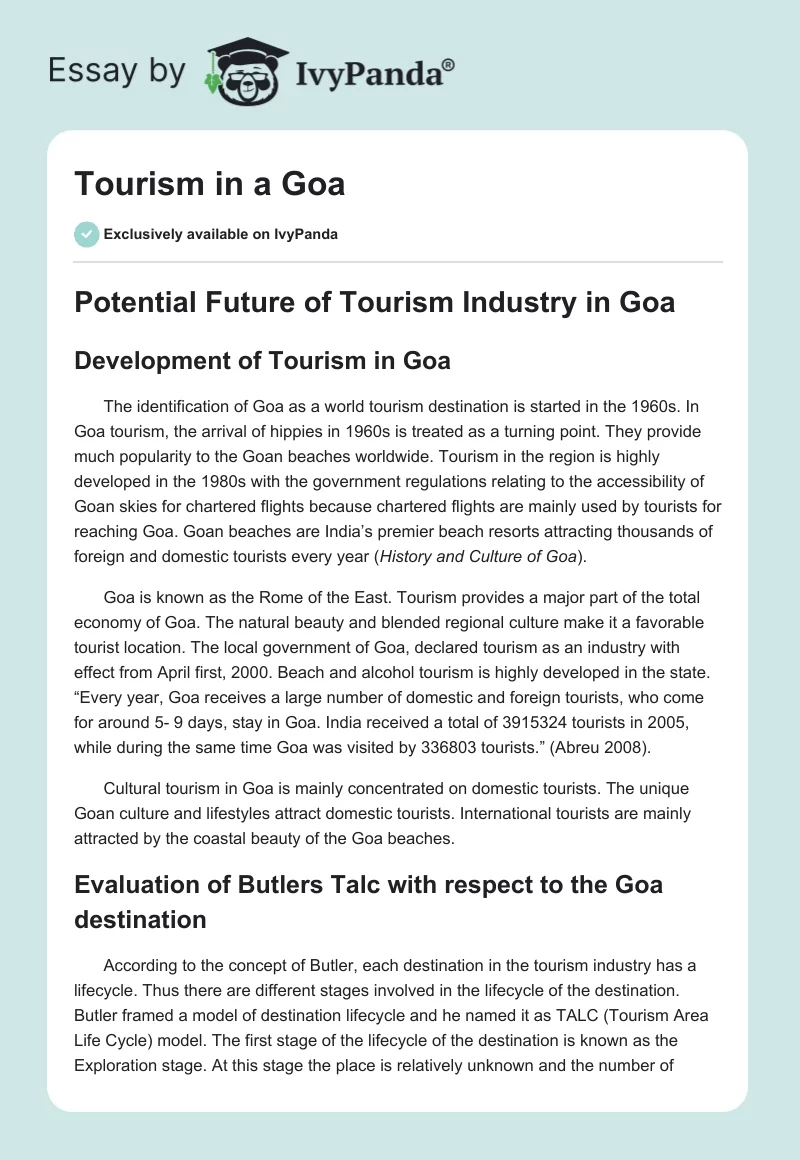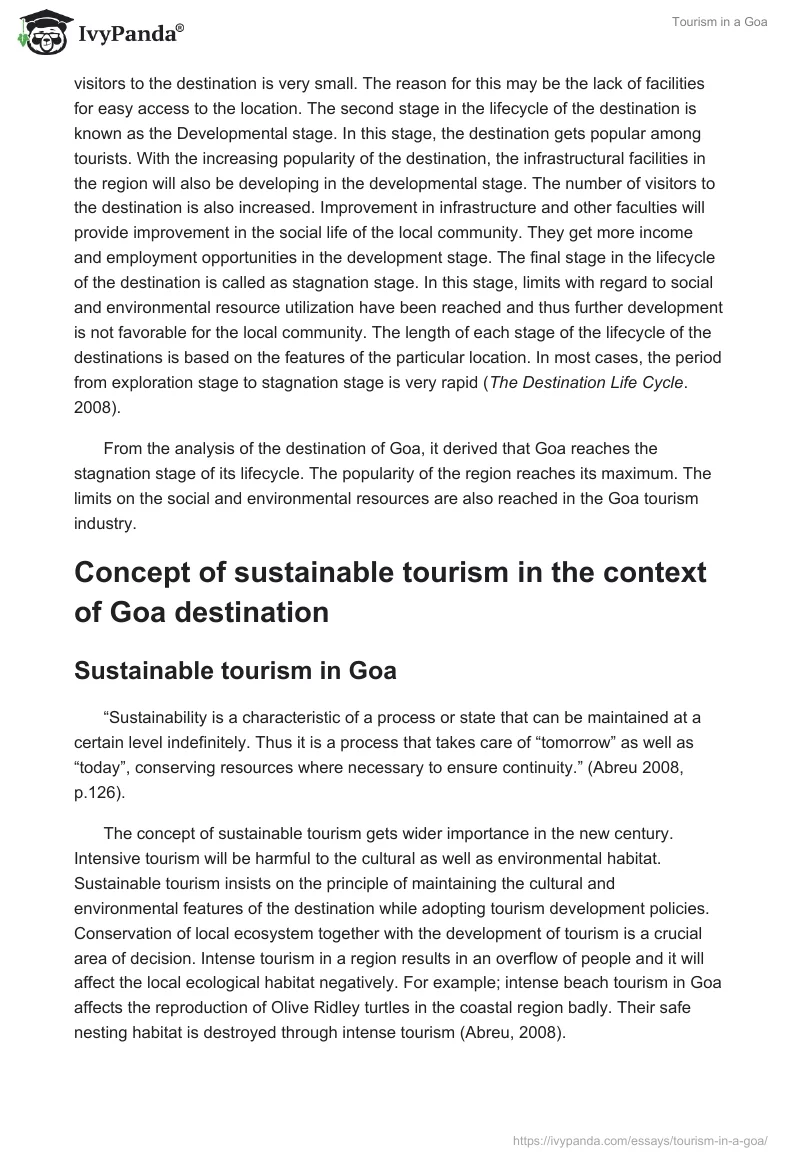Potential Future of Tourism Industry in Goa
Development of Tourism in Goa
The identification of Goa as a world tourism destination is started in the 1960s. In Goa tourism, the arrival of hippies in 1960s is treated as a turning point. They provide much popularity to the Goan beaches worldwide. Tourism in the region is highly developed in the 1980s with the government regulations relating to the accessibility of Goan skies for chartered flights because chartered flights are mainly used by tourists for reaching Goa. Goan beaches are India’s premier beach resorts attracting thousands of foreign and domestic tourists every year (History and Culture of Goa).
Goa is known as the Rome of the East. Tourism provides a major part of the total economy of Goa. The natural beauty and blended regional culture make it a favorable tourist location. The local government of Goa, declared tourism as an industry with effect from April first, 2000. Beach and alcohol tourism is highly developed in the state. “Every year, Goa receives a large number of domestic and foreign tourists, who come for around 5- 9 days, stay in Goa. India received a total of 3915324 tourists in 2005, while during the same time Goa was visited by 336803 tourists.” (Abreu 2008).
Cultural tourism in Goa is mainly concentrated on domestic tourists. The unique Goan culture and lifestyles attract domestic tourists. International tourists are mainly attracted by the coastal beauty of the Goa beaches.
Evaluation of Butlers Talc with respect to the Goa destination
According to the concept of Butler, each destination in the tourism industry has a lifecycle. Thus there are different stages involved in the lifecycle of the destination. Butler framed a model of destination lifecycle and he named it as TALC (Tourism Area Life Cycle) model. The first stage of the lifecycle of the destination is known as the Exploration stage. At this stage the place is relatively unknown and the number of visitors to the destination is very small. The reason for this may be the lack of facilities for easy access to the location. The second stage in the lifecycle of the destination is known as the Developmental stage. In this stage, the destination gets popular among tourists. With the increasing popularity of the destination, the infrastructural facilities in the region will also be developing in the developmental stage. The number of visitors to the destination is also increased. Improvement in infrastructure and other faculties will provide improvement in the social life of the local community. They get more income and employment opportunities in the development stage. The final stage in the lifecycle of the destination is called as stagnation stage. In this stage, limits with regard to social and environmental resource utilization have been reached and thus further development is not favorable for the local community. The length of each stage of the lifecycle of the destinations is based on the features of the particular location. In most cases, the period from exploration stage to stagnation stage is very rapid (The Destination Life Cycle. 2008).
From the analysis of the destination of Goa, it derived that Goa reaches the stagnation stage of its lifecycle. The popularity of the region reaches its maximum. The limits on the social and environmental resources are also reached in the Goa tourism industry.
Concept of sustainable tourism in the context of Goa destination
Sustainable tourism in Goa
“Sustainability is a characteristic of a process or state that can be maintained at a certain level indefinitely. Thus it is a process that takes care of “tomorrow” as well as “today”, conserving resources where necessary to ensure continuity.” (Abreu 2008, p.126).
The concept of sustainable tourism gets wider importance in the new century. Intensive tourism will be harmful to the cultural as well as environmental habitat. Sustainable tourism insists on the principle of maintaining the cultural and environmental features of the destination while adopting tourism development policies. Conservation of local ecosystem together with the development of tourism is a crucial area of decision. Intense tourism in a region results in an overflow of people and it will affect the local ecological habitat negatively. For example; intense beach tourism in Goa affects the reproduction of Olive Ridley turtles in the coastal region badly. Their safe nesting habitat is destroyed through intense tourism (Abreu, 2008).
Increased growth of tourism imposes much pressure on the local resources and the society. Protecting and sustaining the local heritage is highly demanded to maintain the destination as a tourist location for the long term. Environmental degradation and excess utilization of local resources have to be reduced. For this carrying capacity of the state in terms of resources has to identify. The migration of labor has increased in the region and it causes social issues. Sustainable tourism is highly important in all tourism destinations. Goa is a small place but attracting the large number of people. The tourism development must be based on the identification of the carrying capacity of the destination. For ensuring long-term stability in tourism development it has to ensure the participation of the local community in tourism development activities.
The role of the government in the development of Tourism in Goa
The government is highly concentrated on the tourism industry for improving the revenues from tourism. Due to the development in the tourism industry, foreign exchange earnings of the state are highly improved. Employment opportunities, created from tourism is also improved social life. Extensive infrastructural facilities, required for meeting the needs of tourists are built up by the government. Goa’s tourism department provides accommodation facilities at a reduced rate to the tourists through the GTDC Hotels. (Sawker et al 1998).
Services of safeguards are arranged by the government in the coastal region. Roads and infrastructure facilities are developed. For marketing tourism, a corpus fund is created by the government. Subsidies and other financial support to the tourism sectors are provided for developing cost-effective tourism. The heritage house scheme of the government with private participation is also helpful for tourism development. For healthy inbound traffic, a bullet train is arranged (Looking Beyond The Beaches, 2002).
The economic contribution of Goa tourism industry
The tourism industry is the major economic source of the state. It contributes to the economic development of the region through foreign exchange earnings and the creation of employment opportunities for the local community. Tourism plays an important role in the development of the local economy of Goa. “13.7 % of the state’s net domestic product, 7% of employment, 7% of state tax revenue.” is contributed by tourism. (Sawker et al 1998).
Tourism is a prominent industrial sector in Goa. It provides economic contribution from the foreign as well as domestic tourists. “During 2004, more than 2 million tourists flocked to Goa. Being a tourist paradise, Goa attracts domestic traffic too in thousands.” (Business and economy of Goa)
Local government is financially benefited from taxes payments of tourists and their spending for shopping.. “On average, earnings in foreign exchange for the last three years were US$43-57 million. It is estimated that tourism contributes to around, 13.7 percent of Net State Domestic Product; 7 percent of employment and 7 percent to state tax revenues.” (Sawker 1998).
SWOT analysis for identifying the future potential of Goa as a tourism destination
Strengths
Portuguese language, culture, values, and ideals have a strong influence on Goan culture. The natural beauty of Goan beaches provides it the name “land of golden beaches”. Gothic Churches, colonial forts and buildings, and villages provide a picture of the colorful and unhurried Goan lifestyle. Along with its cultural heritage, the golden beaches of Goa make the region an attractive destination on the world tourism map. Six main rivers in Goa provide a chain of inland waterways. Goa festivals are also attractive for tourists (Goa Tourism India, 2008).
“The magnetic scenic beauty is complementary to the historical edifices and its dual cultural traditions, the Latin fusing with the Indian resulting in the unique Goan culture” (Goa Tourism).
Goa provides opportunities in adventure tourism. Facilities for water sports such as sailing, parasailing, windsurfing are arranged in Goan Rivers. Goan museums, worship places, and wildlife sanctuaries make it as an attractive place for tourists of all kinds in the world (Goa Tourism).
Weaknesses
Unplanned over development is the major limitation faced by the Goa tourism industry.
Participation of the local community in tourism is not ensured by the tourism authority. This also affects health tourism in the destination. Goa’s regional development shows the imbalance between different regions. Most of the infrastructural development is located in the tourist destinations. Significant disparity between the coastal and the hinterland regions in socio-economic development affects the development. (Sawker et al 1998).
Opportunities
Adventure tourism
It can be effectively employed in Goa tourism.
Wildlife tourism
Beautiful and exotic species of wildlife in the region are protected by forming 4 wildlife sanctuaries. Flora and fauna in the region is highly attractive. Migratory birds visited Goa in large numbers. Thus wildlife tourism can be adopted as a part of diversified tourism policy.
Medical tourism
It is a recent phenomenon in Goan tourism. World-class medical facilities are arranged in the Hospitals at a comparatively lower costs. Goa has a potential future in medical tourism.
Pilgrimage tourism
Famous religious destination in Goa provides a potential opportunity for pilgrimage tourism in the region. The world heritage site at Old Goa consists of world-famous religious monuments and it provides a great opportunity for heritage tourism.
Architectural tourism
Chapora fort, Teracol fort, and Aloma fort in Goa are attracting tourists.
Yoga Tourism
Peace and tranquility in the region are suitable for mediation and Yoga tourism.
Backwater tourism
Plenty of rivers in the state provide opportunities for backwater tourism.
Threats
Tourism imposes threats to the natural environment of the destination. Dumping use of natural resources and increasing pollution resulted from the overflow of people will negatively affect the long-term sustaining of the destination as a tourist location. Rapid and uncontrolled beach tourism in Goa leads to the loss of biodiversity of the coastal region. (Sawker et al, 1998).
In peak season, tourism earnings lead to economic inflation and this affects the local community badly by increasing prices for commodities and services. (Goa Study Says Tourism’s Adverse Impact Deserves “Urgent Attention”, 2004).
Conclusion
From the SWOT analysis, it derived that Goa has plenty of opportunities in diversified tourism sectors. Its beach tourism is in the stagnation stage and thus sustainable tourism development has to be adopted by the authority in this sector. Unexploited tourism possibilities in the region provide a bright future for Goa tourism. By promoting tourism in the exploration stage sectors, Goa can ensure a long-term existence as a world tourism destination in diversified sectors.
Bibliography
- ABREU, Nirmala De. (2008). Sustainable Tourism in Goa: Number of Tourists Visiting Goa. Conference on Tourism in India.
- ABREU, Nirmala De. (2008). Sustainable Tourism in Goa: Sustainable Tourism. Conference on Tourism in India. 126.
- Business and Economy of Goa. INDFY.com.
- Goa Study Says Tourism’s Adverse Impact Deserves “Urgent Attention”. (2004). India Mike.com: The India Travel Forum. Web.
- Goa Tourism India: Goa Tours. (2008).
- Goa Tourism. Goa Hub.
- Goa Tourism. Goa Hub.
- History and Culture of Goa. India Travel Agents. Web.
- Looking Beyond The Beaches. (2002). Express Travel And Tourism:India’s Travel Business Magazine.
- SAWKER, Kalidas., et al. (1998). Tourism and the Environment: Case Studies on Goa, India, and the Maldives. The Economic Development Institute of the World Bank. Web.
- SAWKER, Kalidas., et al. (1998). Tourism and The Environment: Economic Aspects. The Economic Development Institute of the World Bank. Web.
- The Destination Life Cycle. (2008). Destination Recovery Services.


